Introduction
Managing accounts payable is a crucial aspect of cost accounting that goes beyond number crunching. It involves overseeing pending financial obligations, such as invoices due to suppliers and creditors, to ensure commitments are honored while maintaining cash flow. The implications of accounts payable management extend beyond internal processes, with overdue invoices leading to business closures and impacting liquidity, stress, and productivity levels.
Adapting to evolving financial standards and remaining agile is also essential. The full cycle of accounts payable procedures includes invoice receipt and verification, data entry and coding, approval and authorization, payment processing, and reconciliation and reporting. Automating accounts payable procedures with AI-driven solutions offers numerous benefits, including cost reduction and operational efficiency.
However, businesses must overcome common challenges like invoice inaccuracies and approval bottlenecks. Implementing best practices such as meticulous vendor record upkeep, robust invoice approval systems, and leveraging automation technologies can enhance financial efficiency and strategic financial planning.
What is Accounts Payable?
Managing the flow of funds in and out of an organization is a linchpin of cost accounting, and a particular area of focus is the handling of accounts payable. This involves the diligent oversight of a business's pending financial obligations, such as invoices due to suppliers, vendors, and other creditors. By meticulously tracking these expenses, companies can ensure they are honoring their commitments while also keeping an eye on cash flow.
Effective cost accounting isn't restricted to mere number crunching; it's a strategic tool that spans various industries. In the steel sector, for example, cost accounting is essential for monitoring multiple departments. Standard cost accounting, a commonly adopted method, benchmarks costs against typical production conditions, pinpointing any variances that may signal inefficiencies.
Moreover, the importance of embedding cost-awareness across an organization cannot be overstated. When cost considerations are integrated into the product development cycle as a non-functional requirement—on par with system performance and reliability—it becomes a collective responsibility rather than being siloed within the finance team.
The implications of accounts payable management extend beyond internal processes. Research from the Federation of Small Businesses highlights the dire effects of overdue invoices, with 50,000 business closures potentially avoidable each year if payments were timely. The issue of late payments is so pervasive that only 1% of small businesses have never encountered it, impacting not just liquidity but also stress and productivity levels.
This underscores the need for robust strategies to navigate accounts receivable risks, especially as economic unpredictability looms.
Adapting to evolving financial standards is also a part of this landscape. For instance, the Financial Accounting Standards Board's recent vote to require detailed reporting on software costs reflects a broader trend of increasing transparency and accountability. This new proposal, affecting a wide range of companies, underscores the need for financial operations to remain agile and informed about regulatory changes.
In conclusion, the role of accounts payable within cost accounting is multifaceted and vital for maintaining financial health. It's not just about keeping the books in order, but also about fostering a cost-conscious culture, staying ahead of regulatory shifts, and mitigating the far-reaching consequences of unsettled debts.
The Full Cycle of Accounts Payable Procedures
The accounts payable process is more than just paying bills. It's a series of steps that ensure financial transactions are recorded accurately and efficiently, aligning with the accrual basis of accounting. This method, which is a requirement for publicly traded companies in the U.S., involves recognizing revenue and expenses at the time of transactions, regardless of when cash changes hands.
The full accounts payable cycle starts with the receipt of invoices, followed by meticulous verification to ensure that the goods or services billed have been received and meet the agreed-upon terms. The next step is data entry and coding, which classifies each expense to the correct account, enabling detailed financial analysis and reporting.
Approval and authorization are critical in maintaining internal controls, ensuring expenses are legitimate and within budget before payments are released. This stage is where policies set the groundwork for financial management, promoting transparency and compliance with tax laws and regulations.
Payment processing has evolved with technology, with many organizations shifting towards electronic payments to achieve Straight-Through Processing (STP). This modern approach is known for its efficiency, reducing manual errors and expediting the payment workflow, as noted in a report by the Association for Financial Professionals, where 46% of organizations cited STP as a primary reason for moving away from paper checks.
Finally, reconciliation and reporting complete the cycle, providing an opportunity to review and confirm that all transactions have been captured correctly. This step is essential for accurate financial statements and compliance with regulatory requirements, like the expanded information reporting for Form 1099-K, which aims to increase tax compliance and ease the burden on taxpayers.
In conclusion, by understanding and implementing a robust accounts payable process, businesses can maintain financial health, optimize resources, and stay on the right side of compliance, crucial in an age where financial transparency is not just valued but required.
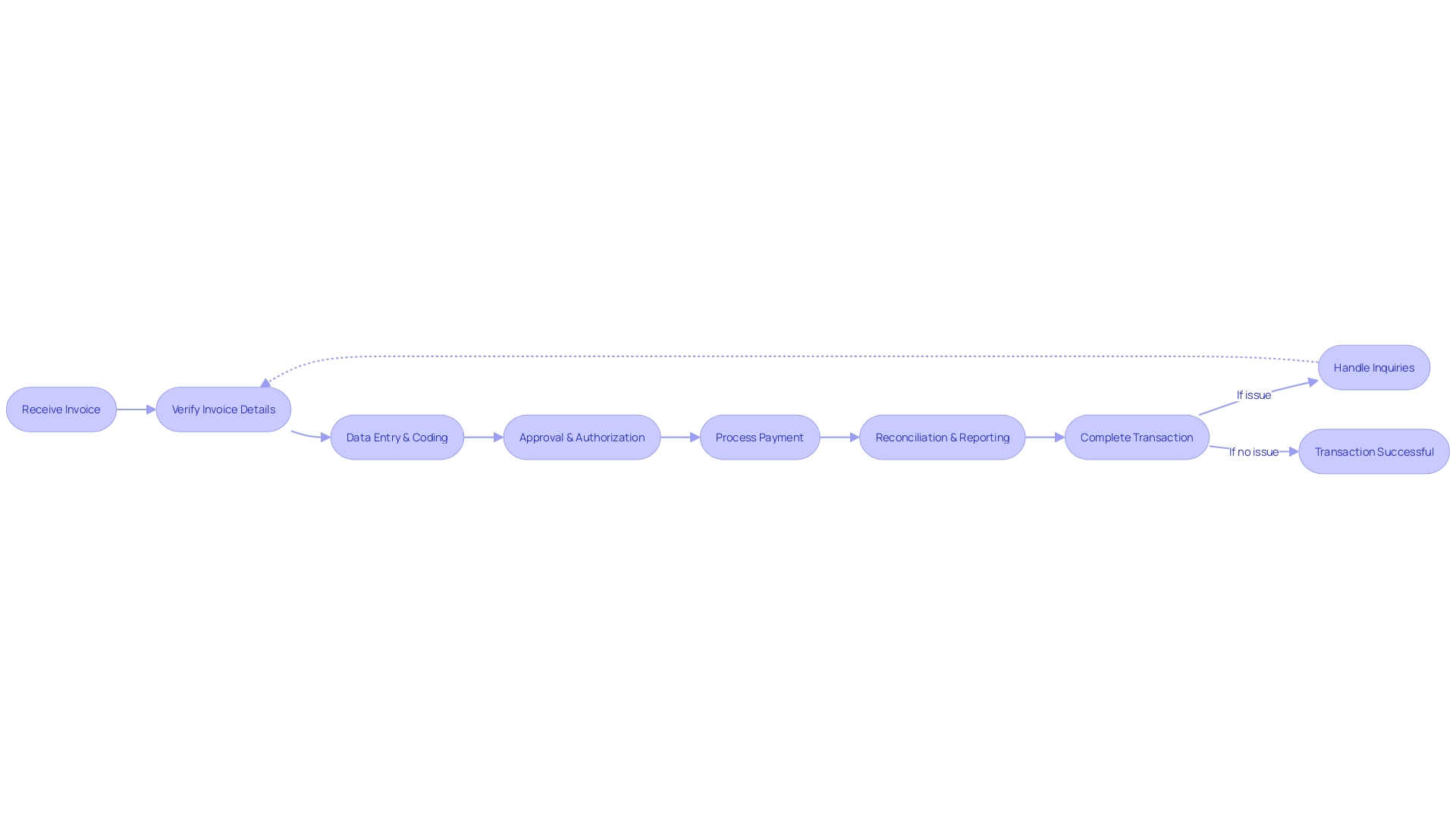
Step 1: Invoice Receipt and Verification
The commencement of the accounts payable process is a critical juncture where precision and accuracy are paramount. It initiates with the meticulous receipt and examination of invoices, a step that demands a careful review to ensure that every invoice reflects the true nature of transactions. The details encompassed within an invoice are not merely requests for payment but represent a structured and detailed breakdown of the goods or services exchanged, as well as the payment obligations that follow.
An invoice, therefore, is far more than a simple document; it is the linchpin in the mechanics of business operations, enabling organizations to maintain a robust cash flow and track financial activities effectively. The key attributes of an invoice include a comprehensive description of the goods or services provided, an invoice number for ease of tracking, and clearly outlined payment terms. This structured documentation is essential for businesses to reconcile accounts, manage finances judiciously, and uphold the integrity of the financial reporting process.
Moreover, integrating innovative technologies, such as artificial intelligence, into the accounts payable and broader accounting processes, can enhance efficiency and accuracy. Companies are increasingly embedding such advanced tools into their accounting systems, aiming to streamline operations and equip their finance teams with the capability to manage complex tasks with greater agility. This is exemplified by the sophistication of platforms like Airbase, which not only comply with stringent procurement controls but also expedite the entire purchasing cycle from initiation to reconciliation.
The careful verification of invoices at the outset of the accounts payable process lays the groundwork for seamless financial operations, ensuring that each subsequent step is built on a foundation of accuracy and reliability.
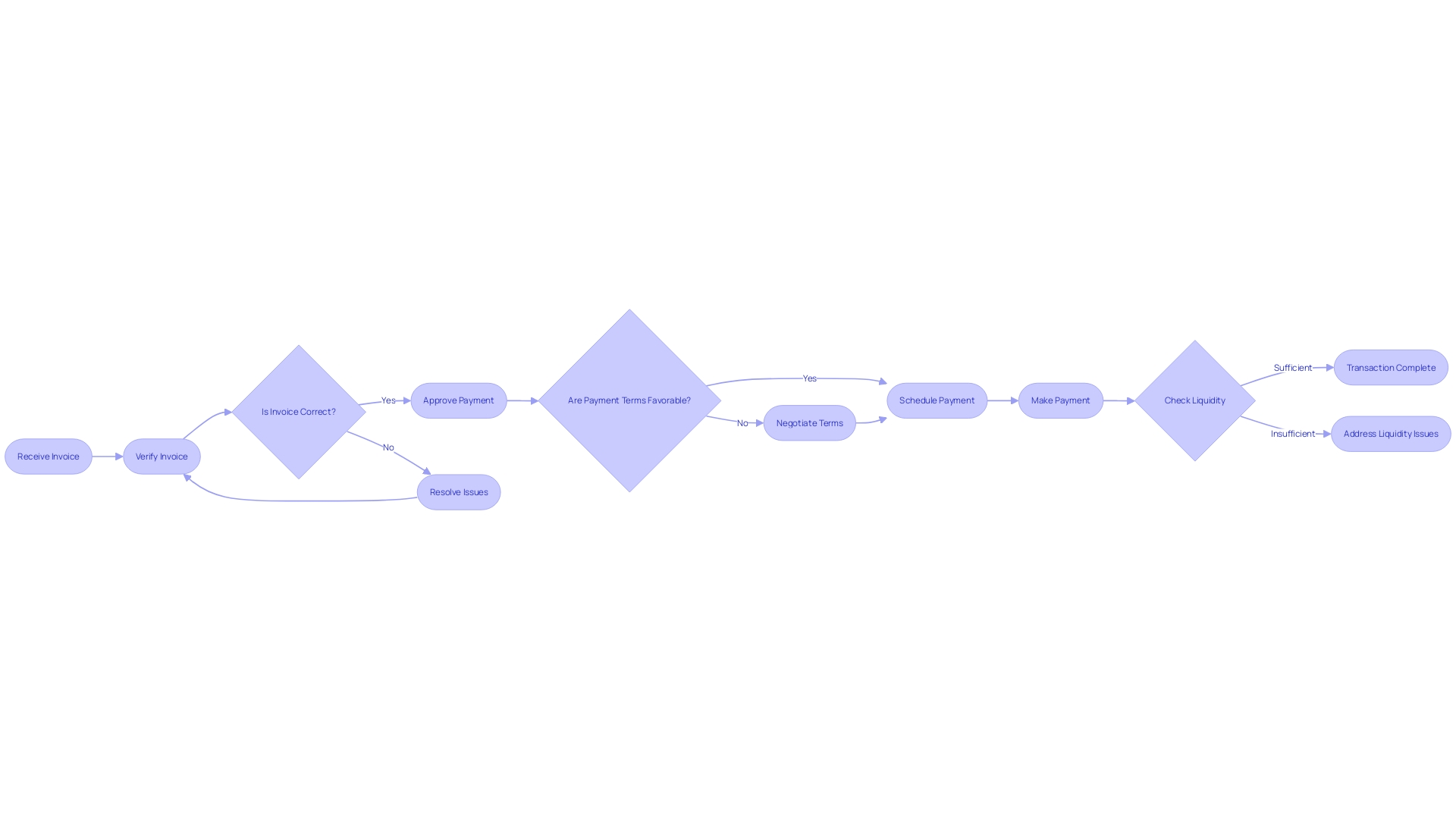
Step 2: Data Entry and Coding
Upon the verification of invoices, it is imperative to integrate them into the cost accounting system. This integration involves assigning specific codes that facilitate meticulous tracking and categorization. Through this systematic coding, invoices become seamlessly retrievable for analysis, ensuring they contribute to an accurate financial representation of the organization's activities.
For example, consider the financial repercussions when unexpected events disrupt routine operations, such as the case when the federal government delayed the decision to declare a national day of mourning for President Reagan. The result was a significant disruption to the usual financial processes, including the review of financial reports.
Moreover, accurate data entry and categorization are akin to the fundamental accounting principle where every financial transaction is a transfer between accounts. Spending $1,500 on a laptop doesn't mean the money vanishes; it transforms into an asset, which must be classified correctly in the accounting system.
The importance of this step has been underscored by recent news from the Financial Accounting Standards Board, which aims to modernize the accounting for software costs, reflecting the significance of correct categorization in financial statements.
Furthermore, with the ongoing shortage of trained accountants, the role of data entry clerks becomes increasingly crucial. They ensure that data, the lifeblood of decision-making, is accurate and reliable. In the healthcare sector, for instance, the standardized coding of medical information underlines the critical nature of proper data entry and categorization for effective communication and digital record-keeping.
This meticulous attention to detail in data entry underpins the integrity of cost accounting, guarding against misconceptions and errors that could arise from improper data capturing, as documented in various case studies. It is a safeguard that ensures the reliability of data that businesses depend on to navigate the complexities of the market and regulatory environments.
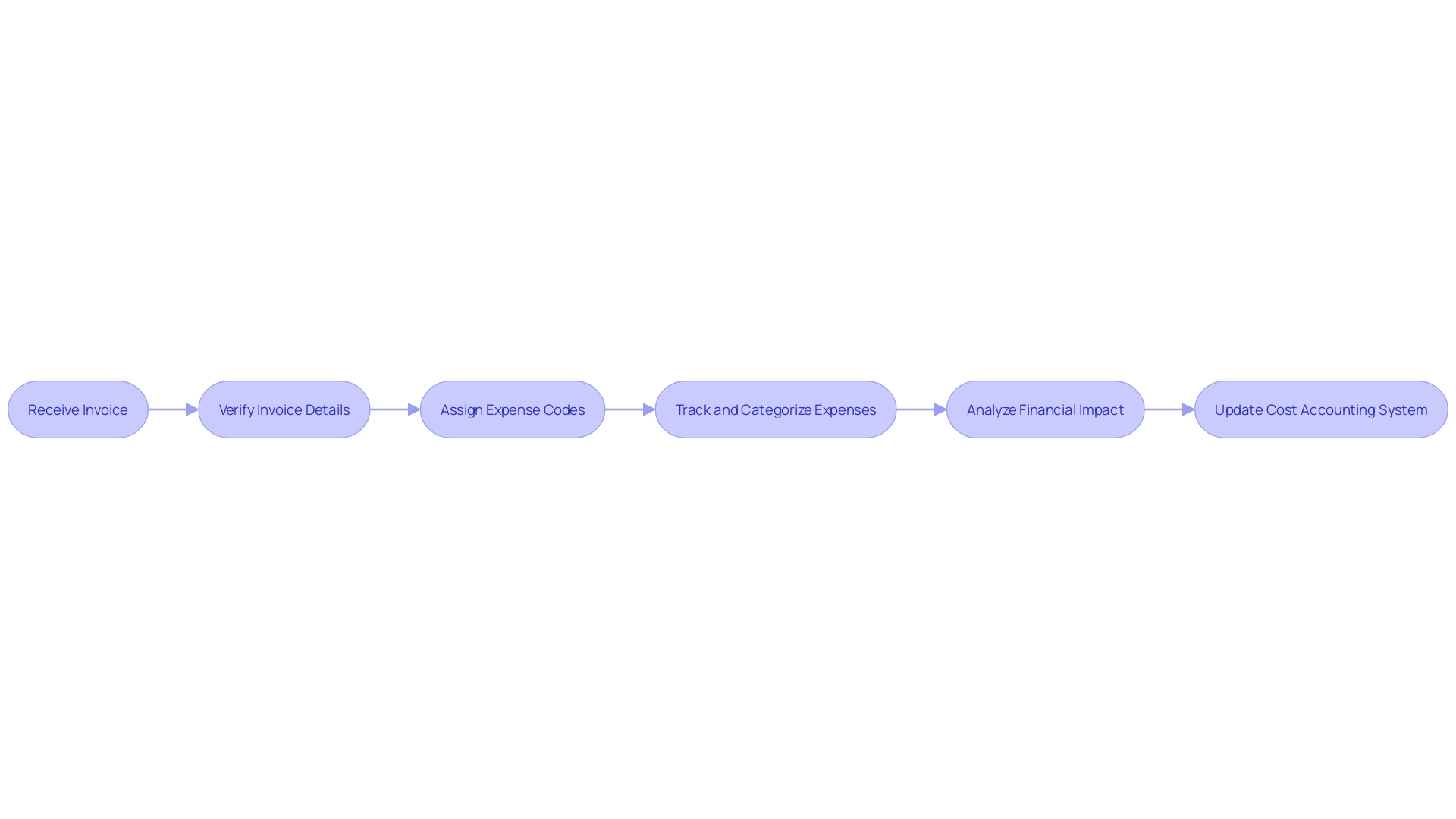
Step 3: Approval and Authorization
Upon receiving invoices, a rigorous validation and authorization process commences. This critical step ensures the integrity of financial commitments by verifying the legitimacy of expenses through a structured approval workflow. Stakeholders such as department heads or managers are integral to this process, endorsing expenditures as consistent with organizational objectives and regulatory compliance.
This system of checks is not merely a formality but a safeguard against fiscal mismanagement and a pillar of transparent corporate governance. It echoes the meticulous nature of regulatory bodies such as the FDA, which upholds public health and safety by rigorously assessing the efficacy and security of medical products.
Moreover, the Financial Accounting Standards Board's recent move to mandate the disclosure of software costs on cash-flow statements underscores the growing emphasis on detailed financial reporting. This reflects a broader trend towards greater financial transparency and accountability, necessitating a robust process for the validation and approval of expenses. As such, the authorization of invoices is not just a procedural step, but a critical component of a cost-aware culture that aligns with the strategic financial management imperative of cost optimization.
Step 4: Payment Processing
Upon final approval of invoices, the accounts payable division springs into action to execute the payment process. This encompasses crafting payment directives, disbursing funds via checks or electronic transfers, and meticulously logging each transaction in the financial ledger. The precision of this process cannot be overstated, as it mirrors the meticulous approach used by PayPal in its nascent stages when managing an influx of a million transactions daily necessitated the expansion of their infrastructure to over a thousand virtual machines.
Emulating the strategic planning seen in high-growth companies, such as the case with Pacific Steel, which restructured its approach to healthcare payments for enhanced transparency and cost control, the accounts payable team also aims for clarity and efficiency. They seek to ensure that financial obligations are settled accurately, reflecting the discipline of cost accounting, where tracking and controlling costs is paramount. In this realm, every payment is an entry that contributes to the broader financial narrative of the organization, akin to the detailed financial records that distinguish accounting from mere bookkeeping.
Moreover, embracing modern payment technologies and methodologies, such as local alternative payment methods (APMs) that resonate with regional preferences and offer cost efficiencies, can further optimize the payment process. This mirrors insights from the Global Payments Report 2023, which underscores the significance of staying abreast with evolving payment trends and consumer behaviors. The accounts payable team's work, therefore, is not just about fulfilling financial obligations, but also about contributing to the company's strategic financial management and operational agility.
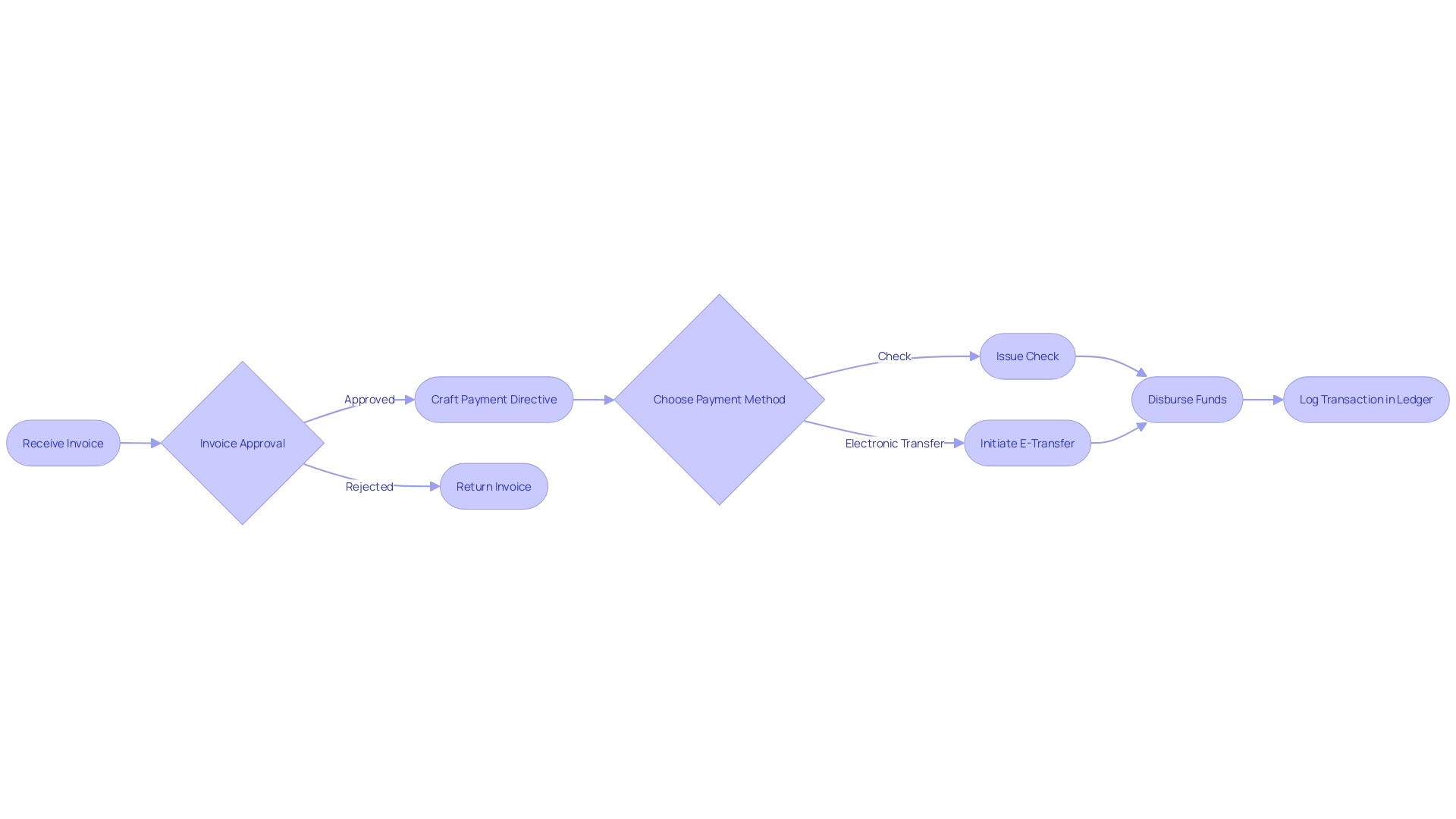
Step 5: Reconciliation and Reporting
The culmination of the accounts payable cycle is not simply a matter of making payments. Rather, it's an intricate process of reconciling each payment against its corresponding invoice and meticulously updating the financial records to reflect these transactions. This step is pivotal in maintaining the integrity of financial data.
Furthermore, generating comprehensive reports is crucial as it sheds light on the company’s financial commitments and provides a clear picture of cash flow. These reports are indispensable tools that enable informed decision-making, ensuring the company's financial health and operational efficiency. In essence, the reconciliation and reporting phase is a critical component in painting an accurate portrait of a business's financial landscape.
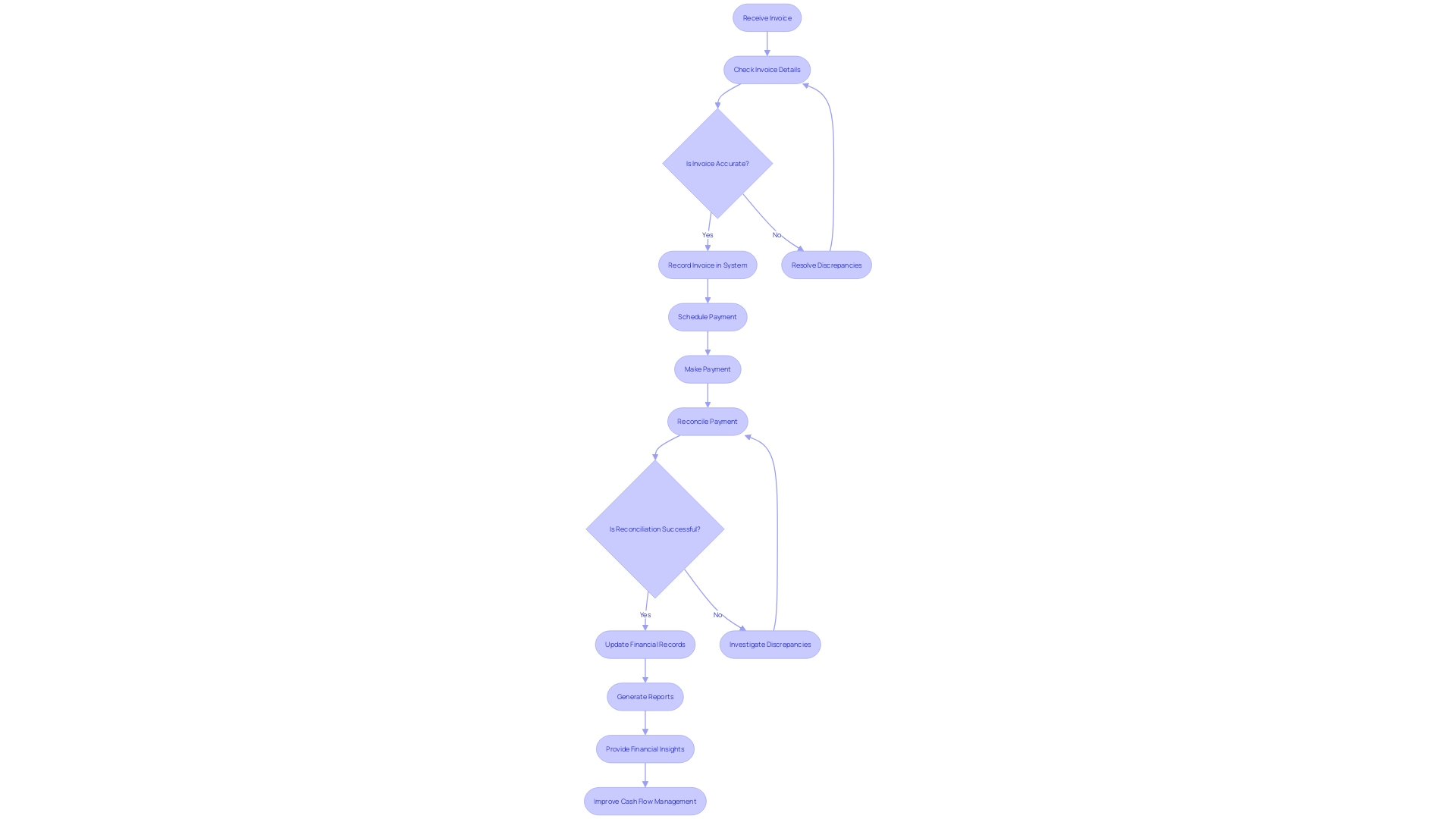
Benefits of Automating Accounts Payable Procedures
Embracing the transformation that artificial intelligence (AI) brings, businesses are increasingly turning to automated accounts payable solutions. This shift is propelled by the desire to diminish overhead costs, especially under the pressure of persistent inflation and escalating expenses. A remarkable surge in the global accounts payable automation market is expected, with projections estimating its growth to $5.3 billion by 2028, expanding at a rate of 11.3% annually.
Technology platforms like Ramp, Bill, Expensify, and AvidXchange, leveraging AI, are leading this change, offering diverse pricing and services tailored to various business needs.
The impact of automation extends beyond just efficiency; it revolutionizes the entire bookkeeping landscape. AI's ability to recognize data, make decisions, and analyze patterns transforms operations that once took days into tasks that can be completed in minutes. With current statistics indicating that up to 80% of financial operations are ripe for automation, the adoption of these technologies has the potential to liberate a vast amount of time for employees, allowing them to focus on strategic initiatives and enhance customer satisfaction.
Moreover, the strategic implementation of these digital solutions can lead to a seamless Omni-channel customer experience, as opposed to the less effective multi-channel approach. For large organizations like Delivery Hero, with a workforce of over 53,000, automation has been instrumental in overcoming operational challenges, such as account recovery processes which previously consumed 35 minutes per incident. Under astute leadership, the integration of automation in their IT service delivery has significantly reduced downtime for employees, showcasing the tangible benefits of this technological evolution.
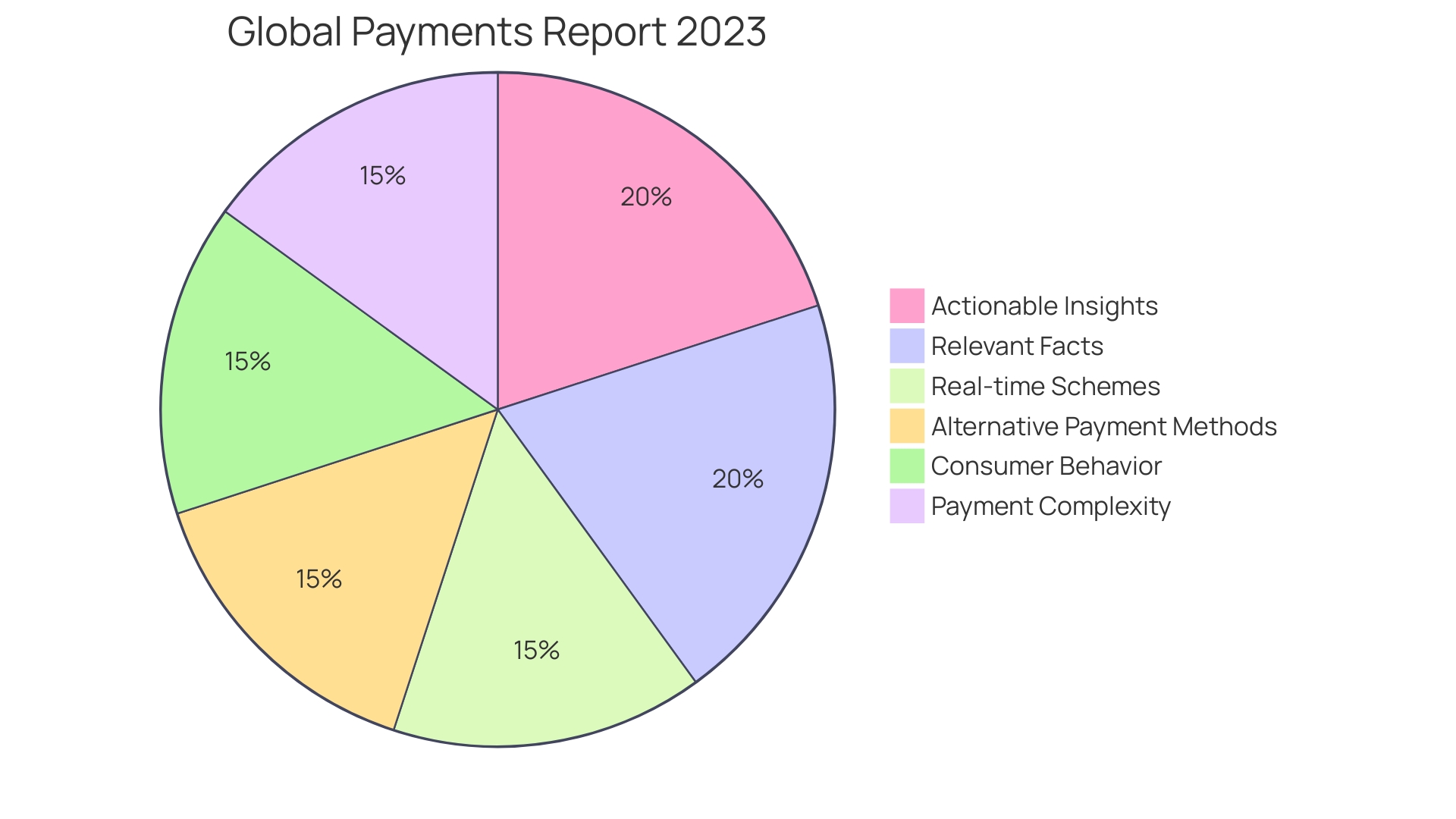
Common Challenges in Accounts Payable and How to Overcome Them
Enhancing accounts payable processes is critical for businesses grappling with invoice inaccuracies, approval bottlenecks, and redundant payments. Embracing technology solutions is a key strategy in this regard; as evidenced by firms like Diana Cupps Law, which prioritizes meticulous, client-centric service delivery, technology can streamline payment solutions and drive efficiency. Just as a chef carefully curates a prix fixe menu, businesses can select fixed-price tech services that bolster operational efficacy, drawing inspiration from industry professionals like Chris, who applies his restaurant background to improve accounting practices.
Firms are increasingly turning to automation to mitigate the inflationary pressures and operational challenges posed by the current macroeconomic climate. The automation of accounts payable is not just a trend but a necessity, with the market projected to reach $5.3 billion by 2028, growing at an annual rate of 11.3%. By adopting platforms like Ramp, Bill, Expensify, and AvidXchange, businesses can eliminate manual intervention in invoice processing, thereby reducing overheads and enhancing financial control.
In this dynamic landscape, internal controls, regular audits, and clear communication with suppliers become indispensable. This ensures not only compliance but also the strategic management of finances. As the global economy contends with the aftermath of the pandemic, supply chain disruptions, and geopolitical uncertainties, the role of accounts payable automation in maintaining financial health cannot be overstated.
It transforms the way businesses handle their financial transactions, much like the evolution from Visicalc to Excel, marking a significant leap in efficiency and user experience.
Moreover, automation aligns with the fundamental need for precision in financial transactions. According to CFO.com, incorrect purchase order information accounts for 49% of disputes, highlighting the necessity for accuracy. For small businesses, where streamlined accounts payable can significantly impact cash flow—a top priority for 85% of owners—automation serves as a strategic tool for financial resilience.
It's a shift from mere transaction processing to strategic expense management and reporting, as aptly demonstrated by the strategic AR mindset shift that many companies are now adopting in response to inflation and supply chain unreliability.
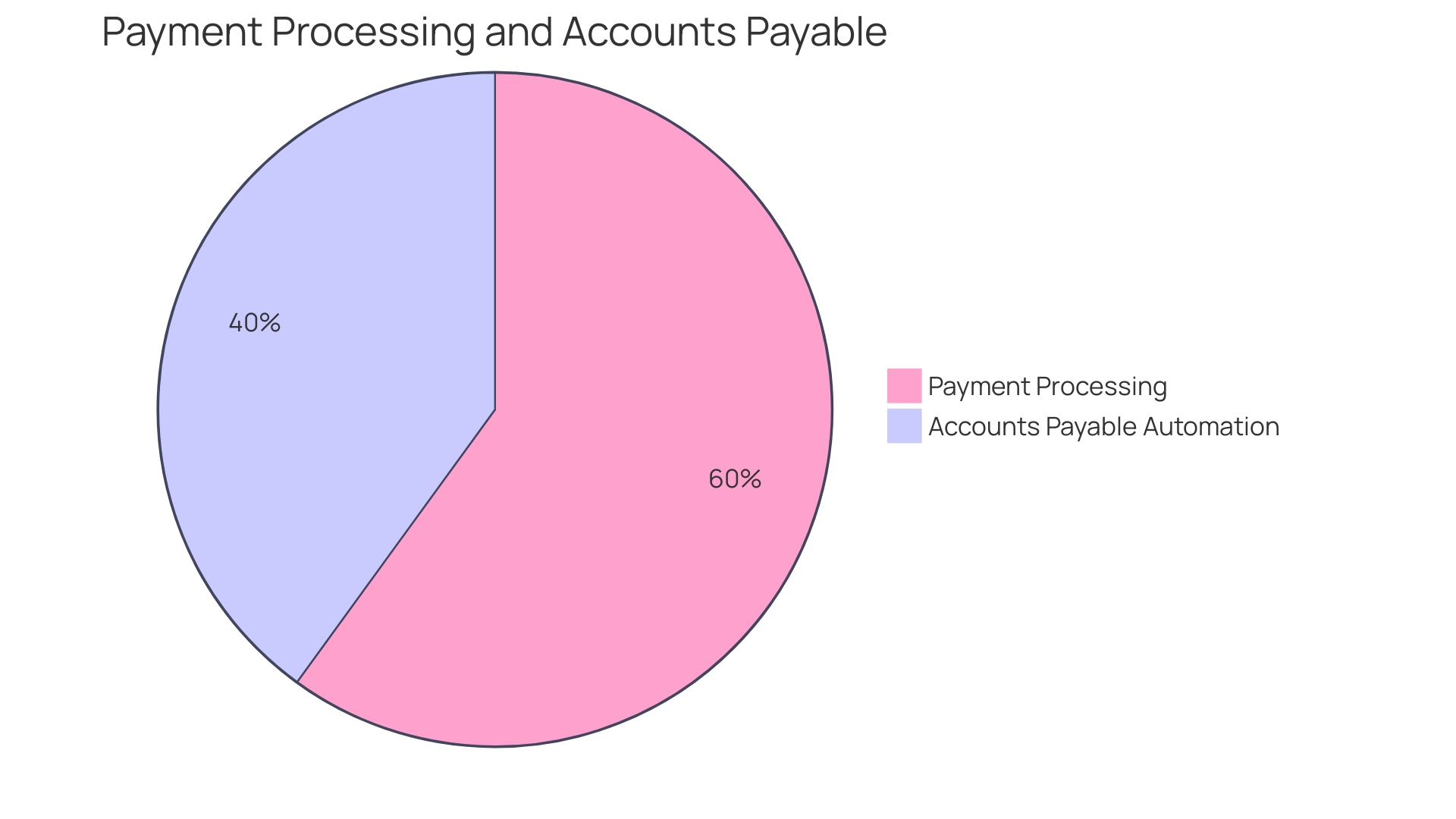
Best Practices for Managing Accounts Payable
Sharpening the accounts payable (AP) process is pivotal for businesses seeking to enhance financial efficiency. Meticulous vendor record upkeep, coupled with a robust invoice approval system, is the cornerstone of an effective AP strategy. By rigorously scrutinizing and reconciling accounts, companies can ensure their payment terms are optimized for their cash flow needs.
However, the true game-changer in AP management is leveraging automation technologies. With the global accounts payable automation market projected to surge to $5.3 billion by 2028, organizations are increasingly adopting platforms like Ramp, Bill, Expensify, and AvidXchange. These solutions, powered by artificial intelligence, are revolutionizing the AP landscape by minimizing human intervention, thus reducing errors and enhancing operational efficiencies.
By integrating such systems with Enterprise Resource Planning (ERP) platforms, businesses can achieve seamless payment workflows, providing real-time actionable data and centralizing financial data to eliminate silos. As a result, a more streamlined, efficient, and transparent financial ecosystem is established, leading to improved cost management and strategic financial planning.
Conclusion
In conclusion, effectively managing accounts payable is crucial for maintaining financial health and operational efficiency. Late payments and invoice inaccuracies can have dire consequences, impacting liquidity, stress levels, and productivity. To overcome these challenges, businesses should implement best practices such as meticulous vendor record upkeep, robust invoice approval systems, and leveraging automation technologies.
Automating accounts payable procedures with AI-driven solutions offers numerous benefits, including cost reduction and operational efficiency. Adapting to evolving financial standards and remaining agile is also essential. In summary, by implementing best practices and leveraging automation technologies, businesses can enhance financial efficiency, optimize resources, and achieve strategic financial planning.




